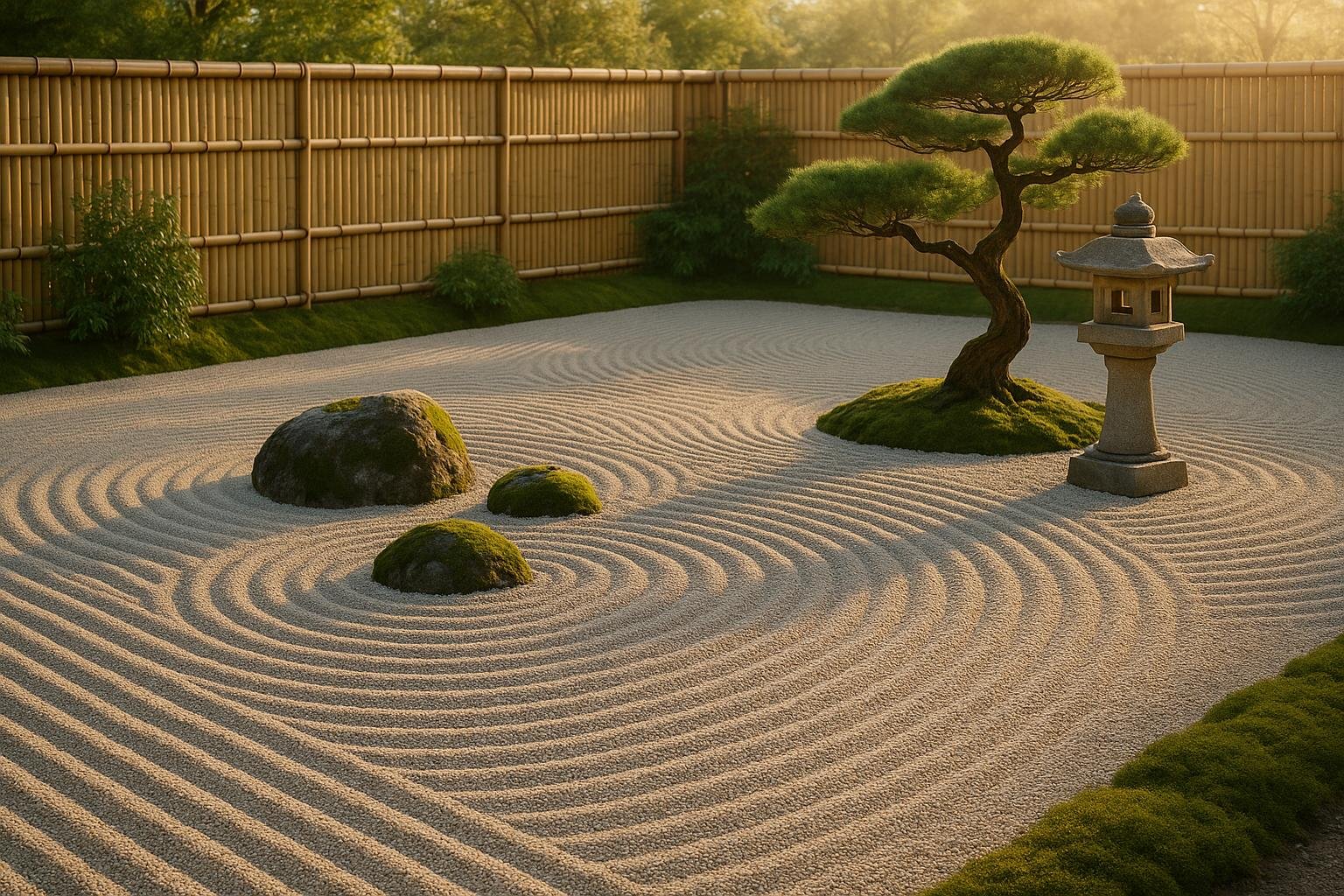Checklist for Zen Garden Structure Maintenance

Maintaining a Zen garden is essential to preserve its serene beauty and calming atmosphere. Here's a quick guide to the key tasks:
-
Daily/Weekly Tasks:
- Rake gravel patterns to keep designs sharp.
- Check and clean stones for stability and debris.
- Care for moss by removing debris and misting during dry spells.
-
Monthly/Seasonal Tasks:
- Inspect and clean water features, pumps, and filters.
- Maintain bamboo fences by checking for pests and applying sealant every 12–24 months.
- Level and repair sand borders as needed.
-
Weather-Specific Care:
- Protect plants and structures during winter with mulch, wraps, or covers.
- Prepare for storms by securing loose items and ensuring proper drainage.
- Mist moss frequently during dry weather to prevent browning.
-
Tool and Record Keeping:
- Clean, sharpen, and store tools properly to extend their lifespan.
- Keep a maintenance log and take photos to track progress and seasonal changes.
Zen Garden Maintenance

Daily and Weekly Tasks
Keeping your Zen garden in top shape requires consistent care. By dedicating time daily and weekly, you can maintain its serene beauty and balance. Here's how to stay on top of your garden's needs.
Gravel Pattern Maintenance
- Smooth the gravel using a fine-toothed metal rake.
- Follow up with a wide-toothed rake to create precise, flowing patterns.
- Lightly moisten the gravel to help the patterns hold their shape longer.
When crafting patterns, work methodically from one end to the other. Stand at the garden's edge and use long-handled tools to avoid leaving footprints or disrupting the design.
Stone Position Checks
Set aside time weekly to ensure your stones remain in place and in good condition:
- Check each stone for stability and signs of shifting.
- Clean them gently with a soft brush to remove dirt or debris.
- If larger stones have moved, secure them with smaller supporting rocks.
Moss Care Guide
Moss thrives with attentive care, especially in the early morning when the air is cool and calm. Here’s what to do:
- Use a soft brush or tweezers to carefully remove debris.
- Inspect the moss for any damage or signs of dryness.
- Mist lightly during dry spells and clear away any fallen leaves.
Since moss absorbs moisture from the air, keeping it hydrated and free of debris is key. Early morning care not only promotes its health but also enhances the tranquil vibe of your garden for the rest of the day.
Regular Structure Checks and Fixes
Stone and Granite Care
Taking care of stone and granite features not only extends their life but also keeps your garden looking its best. Start by cleaning the stones with a stiff brush and water. If there are tougher stains, a mix of mild detergent and water should do the trick. To shield the stones from weather damage and stains, apply a high-quality sealant. During winter, cover them with weather-resistant fabric to protect against frost damage.
Proper drainage is also key to preventing water-related issues. Here’s how to ensure it:
- Create a slight slope of about 1/4 inch per foot to direct water away.
- Place gravel beneath and around the stones for better drainage.
- Check that water flows away from stone structures, not toward them.
Once the stones are taken care of, move on to inspecting other structural elements.
Bamboo Fence Maintenance
Bamboo fences add charm to any garden, but they need regular upkeep to stay in good shape. Inspect them every three months for signs of trouble such as pest infestations, discoloration, mildew, splintering, or any structural instability.
To keep the bamboo protected, apply a sealer every 12 to 24 months. Make sure to trim back nearby plants to reduce moisture buildup and prevent pests from settling in. Also, check all securing points to ensure they’re tight but not causing damage to the bamboo.
Sand Border Repairs
Sand borders can tie a garden’s design together, but they require consistent maintenance to stay neat and functional. Here’s a simple guide to keeping them in shape:
| Task | Frequency | Key Actions |
|---|---|---|
| Inspect | Weekly | Look for alignment and signs of wear |
| Debris Removal | Daily | Sweep away leaves and dirt |
| Level Check | Monthly | Ensure sand height is even |
| Border Repair | As needed | Fix or replace damaged sections |
When installing or repairing sand borders, use a level to keep everything even. Compact the sand base firmly to prevent shifting and maintain consistent levels. Regular sweeping helps avoid debris buildup, which can lead to unevenness.
Keep an eye out for loose edges, uneven sand, water pooling, or plants encroaching on the borders. Address these problems quickly by adding fresh sand and compacting it well to keep the borders stable and tidy.
🚀 Ready to Reinvent Your Garden?
Join thousands of homeowners who have transformed their gardens using our AI design tool. Upload one photo to explore endless possibilities.
Get your AI garden designs →Water Feature Maintenance
Once you've addressed the stone, granite, and bamboo elements, it's time to shift your attention to maintaining your water features. Proper care ensures they remain functional, visually appealing, and healthy for any aquatic life.
Pump and Filter Care
The pump and filter are the backbone of any water feature. Regular maintenance keeps them running efficiently and extends their lifespan. Clean the pump at least once a year, or more frequently if your area is prone to debris. When disassembling, document the parts for easier reassembly.
| Component | Cleaning Frequency | Key Actions |
|---|---|---|
| Pump | Annually (or more often in high-debris areas) | Remove the pump, clean the outer cage, and inspect for wear or damage |
| Filter Media | Monthly | Clean filter media using pond water to protect beneficial bacteria |
| Skimmer | Weekly | Remove debris and check water flow |
An annual deep cleaning of the entire system is also essential to catch potential issues early.
"The pump in your backyard pond is the heart of it. The filter is much like its liver. Both work to ensure your pond is clean and clear and healthy for any fish living it." - Tampa Bay Ponds & Rocks
Koi Pond and Pool Care
Koi ponds require consistent care to maintain water quality and the health of the fish. Remove 10–25% of the pond water weekly or monthly, depending on the pond's size and the number of koi.
Here’s a simple care routine to follow:
- Test water parameters weekly to ensure balance.
- Remove floating debris daily to prevent buildup.
- Clean skimmer filters every week.
- Service biofall filters three times a year.
- Perform a full cleaning each spring.
Keep in mind that koi need 10 gallons of water per inch of their length. During warmer months, closely monitor oxygen levels, as heat can reduce the water's oxygen content.
Dry Stream Bed Cleaning
Dry stream beds are low-maintenance, but they still require occasional attention to keep them looking their best and functioning properly.
- Weekly Maintenance: Use a flexible leaf rake to clear debris between stones.
- Seasonal Cleanup: Rinse the pebbles in spring and fall to wash away soil and weed seeds.
- Every Five Years: Conduct a thorough maintenance session:
- Disassemble the stream bed.
- Deep clean all components.
- Check the weed barrier for any damage.
- Reposition shifted rocks.
- Add fresh mulch if needed.
"Dry streams require only occasional maintenance - just the removal of debris that may become wedged among the rocks after a storm. If twigs and fallen leaves are allowed to accumulate they can interfere with the movement of water." - Paula Refi
After storms, inspect for any displaced rocks and make adjustments to preserve the flow of your design. Ensure the woven weed barrier remains intact to prevent weed growth while allowing dust to wash away naturally.
sbb-itb-4d6a8dd
Weather and Season-Based Care
Winter Protection Steps
Winter care for your Zen garden is all about shielding it from freezing temperatures and snow. Protect delicate structures and plants by using the right materials and methods.
| Garden Element | Protection Method | Maintenance Frequency |
|---|---|---|
| Young Trees | Wrap trunks with white reflective tree guard wrap | Install in early fall; remove in spring |
| Shallow-rooted Plants | Add a 3–4 inch layer of mulch | Apply before the first frost |
| Container Plants | Use fiberglass or wood planters, or line containers with styrofoam | Prepare in late fall |
| Japanese Maples | Cover with white plastic (not clear) | Use during freezing periods |
For container plants, opt for insulated, weather-resistant containers to keep roots safe. Interestingly, snow acts as a natural insulator for dormant hardy plants. However, for larger plants and trees, be sure to remove excess snow to prevent branches from snapping under the weight.
Water management is also critical during winter:
- Check soil moisture when snowfall is less than 2 inches per week.
- Only water when nighttime temperatures stay above freezing.
- Keep a close eye on newly planted vegetation and evergreens.
Storm Protection Guide
Once winter prep is complete, shift focus to storm readiness. Storms can wreak havoc on your Zen garden, so securing loose items and safeguarding delicate features is essential.
"High-speed winds can turn loose objects into hazards." - The National Association of Home Builders
Prepare a pre-storm checklist to minimize damage:
- Bring portable elements indoors.
- Secure permanent structures firmly.
- Cover fragile plants with burlap.
- Clear out drainage systems to prevent blockages.
- Lower or remove adjustable garden features.
For stone and gravel areas, ensure stability and proper drainage to avoid water pooling during heavy rains. Regular checks on permanent structures can go a long way in keeping everything intact.
Dry Weather Care
Dry spells demand extra care, especially for moss and sand elements in your Zen garden. Moss thrives on consistent moisture, so a little extra effort can keep it lush.
Moss care tips during dry periods:
- Mist regularly using treated water.
- Let tap water sit for 24–48 hours before use to reduce chlorine.
- Watch for browning, which could signal sun damage.
- Provide shade to retain moisture and prevent drying out.
"Zen gardeners devote many hours to this mechanical chore [raking patterns]; the repetitive activity clears the mind of mundane concerns and helps produce a state of pure concentration." - Bruce A. Coats
For sand and gravel areas, dry weather often means more debris and fading patterns. Rake more frequently to keep the designs sharp and clear. To cut down on weeds, consider laying landscape fabric beneath the gravel. This simple step keeps the garden looking serene while reducing upkeep.
Tool Care Guide
Keeping your tools in top shape is just as important as maintaining the serenity and precision of your Zen garden. A little care goes a long way in ensuring your tools last and perform at their best.
Tool Cleaning and Sharpening
Regular cleaning and sharpening are key to keeping your tools efficient and durable. After each use, a quick clean-up helps prevent buildup and wear.
| Task | Frequency | Method |
|---|---|---|
| Basic Cleaning | Daily | Rinse with a hose and scrub with a wire brush |
| Disinfection | After diseased plants | Use a 10% chlorine solution or rubbing alcohol |
| Sharpening | Weekly/Monthly | Use a whetstone or a specialized sharpener |
| Deep Clean | Seasonally | Disassemble, remove rust, and apply lubricant |
Cutting tools like pruners need extra attention. A pruner sharpener or whetstone can help maintain their edge, making every cut smooth and precise.
For metal tools, follow these steps:
- Scrub off dirt with a wire brush.
- Remove sticky sap with Teflon pads.
- Dry tools completely before applying a light coat of protective oil to prevent rust.
Wooden handles also need care. Sand them down to remove rough spots and treat them with boiled linseed oil to keep them from cracking or splitting over time.
"A regular maintenance routine keeps your garden tools in good working order and helps them last longer. Tools not only need to be sharp, but also clean and sterile."
– Linda Hagen
Once your tools are clean and sharp, storing them properly is the next step.
Tool Storage Guide
Proper storage is essential for extending the life of your tools and keeping them ready for use. Moisture is a tool's worst enemy, so always ensure they are dry before putting them away.
Here are some storage tips to protect your tools:
- Clean and dry tools thoroughly before storing.
- Hang tools on wall-mounted racks to promote air circulation.
- Keep metal parts off the ground to avoid contact with moisture.
- Store tools in a well-ventilated area.
- Apply a protective oil coating if storing for an extended period.
For your Zen garden tools, a sand bucket storage solution can be especially helpful. Fill a bucket with clean sand mixed with plant-based oil. Plunging metal tools into the sand helps clean their surfaces and prevents rust during storage.
A little effort in cleaning, sharpening, and storing goes a long way in preserving your tools and ensuring they’re always ready to help you maintain your garden's tranquil beauty.
Record Keeping
Keeping detailed records of your Zen garden's care helps maintain its peaceful essence and track its progress over time. Below, we’ll explore ways to document your garden visually, log maintenance activities, and use digital tools to streamline your efforts.
Garden Pattern Photos
Taking photos of your garden's patterns and features is a great way to document its evolution and draw inspiration. Capture images from different angles to highlight:
- Gravel and sand patterns
- Stone arrangements
- Plant placements
- Seasonal transformations
- Overall garden layout
| Photo Type | Frequency | Purpose |
|---|---|---|
| Pattern Documentation | Monthly | Track design evolution |
| Seasonal Views | Quarterly | Document weather impact |
| Maintenance Issues | As needed | Record problem areas |
| Structure Details | Bi-annually | Monitor wear and repairs |
Save these photos with dates and short notes to create a detailed visual history of your garden.
Maintenance Log Guide
Keeping a maintenance log ensures you stay on top of routine tasks and can address issues as they arise. Include details such as:
- Dates of routine maintenance
- Materials used (e.g., types and amounts of gravel or sand)
- Plant care activities
- Repairs to structures
- Impact of weather events on the garden
Organize your log into sections for daily, weekly, and seasonal tasks. Document any challenges you face and how you resolved them - this can serve as a helpful reference for future upkeep.
Digital Planning Tools
Tools like AIGardenPlanner bring convenience to Zen garden maintenance. This platform offers features tailored to your garden’s specific needs, such as:
- Custom maintenance schedules based on garden elements
- Photo documentation tools
- Plant care reminders
- Weather-based maintenance alerts
- Digital garden mapping
The AI-powered system not only helps you plan tasks but also provides recommendations based on your garden's layout and local climate. You can use pre-designed templates to log seasonal changes and routine care, ensuring nothing is overlooked.
"A Zen garden to me symbolizes the beauty of nature in its purest undiluted form, stripped of everything that is unessential... Such a garden should give you an immediate sense of peace and tranquility. It is not just a visual thing; it has a deeper spiritual quality." - Peter Chan, Owner of Herons Bonsai
🎨 Visualize Your Dream Garden Today!
Transform any outdoor space into a professional landscape design in minutes. Just upload a photo, choose your style, and let our AI do the rest.
Start your garden transformation now →Conclusion: Keeping Your Zen Garden in Shape
Taking care of your Zen garden is an ongoing commitment, but it’s one that pays off in serenity and beauty. Regular maintenance stops small problems from turning into bigger ones, ensuring your garden stays as peaceful as the day you first created it.
A consistent schedule of monitoring and timely fixes makes the work manageable. Tools like AIGardenPlanner can help by setting reminders and keeping track of essential tasks, so nothing gets overlooked.
Here’s an example of a maintenance schedule you can follow:
| Maintenance Category | Recommended Frequency | Benefits |
|---|---|---|
| Stone Structure Care | Bi-weekly | Prevents moss buildup and ensures stability |
| Gravel Pattern Upkeep | Every 2–3 weeks | Maintains design and supports proper drainage |
| Water Feature Cleaning | Monthly | Keeps water clear and extends pump life |
| Border Maintenance | Quarterly | Stops erosion and keeps edges well-defined |
By weaving these tasks into your routine, you turn maintenance into a meditative practice. It’s not just about preserving the garden itself but also nurturing the sense of calm it brings. With tools like AIGardenPlanner, you can stay organized and ensure your Zen garden remains a sanctuary of peace.
"A Zen garden to me symbolizes the beauty of nature in its purest undiluted form, stripped of everything that is unessential... Such a garden should give you an immediate sense of peace and tranquility. It is not just a visual thing; it has a deeper spiritual quality." - Peter Chan, Owner of Herons Bonsai
FAQs
How often should I seal my bamboo fence to keep it in good condition?
To keep your bamboo fence in great shape and make it last longer, apply a sealant every 18 months to 2 years. If you’re in a region with harsh weather - like scorching heat, heavy rain, or freezing winters - sealing it once a year can offer extra protection. Regular sealing shields your fence from moisture, UV rays, and pests, helping it stay sturdy and looking good for years.
How can I protect my Zen garden from damage during storms or heavy snowfall?
To keep your Zen garden safe and intact during extreme weather, here are some practical steps you can take:
- Secure lightweight items: Bring in any small decorations, tools, or furniture that could be damaged or blown away by strong winds. If that's not possible, anchor them firmly in place.
- Prune weak branches: Trim dead or fragile branches from trees and shrubs to reduce the risk of them snapping and damaging your garden.
- Protect vulnerable plants: Use burlap or frost cloth to cover delicate plants, shielding them from snow, ice, and freezing temperatures.
- Gently remove snow: If snow accumulates, use a broom to carefully brush it off branches. Be gentle to avoid harming the plants while preventing breakage.
- Ensure proper drainage: Check that water can flow away easily to prevent pooling, which can cause root rot during heavy rains.
By preparing ahead, you can help your Zen garden weather the storm and maintain its serene charm.
What’s the best way to care for moss in my Zen garden during dry weather?
To keep your moss in top shape during dry weather, it's all about consistent, gentle care. Light, regular watering is key to keeping the surface moist without overdoing it. While moss can handle dry spells by going dormant, a steady routine of light watering will keep it lush and full of life.
Make sure to shield the moss from extended periods of direct sunlight, as too much heat can lead to yellowing. A quick misting now and then is a great way to maintain humidity, especially if you’re dealing with dry air. Also, take a moment to clear away any debris or weeds - this prevents competition for moisture and nutrients. With these simple steps, your moss can stay healthy and vibrant, even when the weather isn’t perfect.
Related posts
Related Articles

Spring Garden Planning Checklist: Essential Steps for Success
Prepare your garden for spring with essential steps, including soil testing, tool maintenance, and planting schedules for a thriving season.

Ultimate Guide to Sustainable Minimalist Landscaping
Explore sustainable minimalist landscaping for a stylish, eco-friendly garden that requires less maintenance and conserves resources.
Ultimate Guide to Creating a Stunning Front Yard Succulent Garden
Discover the benefits of front yard succulent gardens and learn how to choose the right succulents and design your outdoor space with our comprehensive guide.

AI-Driven Garden Furniture Placement: How It Works
Transform your garden with AI-driven furniture placement that optimizes style, comfort, and functionality based on your space and preferences.

Battery Irrigation Trends for Smart Gardens
Explore the latest trends in battery-powered irrigation systems, blending smart technology and eco-friendliness for efficient garden management.

Drought-Resistant Landscaping: A Complete Guide
Transform your garden into a stunning, drought-resistant landscape with smart design, plant choices, and efficient watering methods.